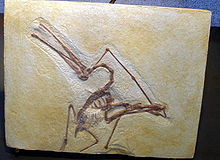- Ctenochasma
-
Ctenochasma
Temporal range: Late Jurassic, 150 Ma
Fossil specimen of C. elegans Scientific classification 
Kingdom: Animalia Phylum: Chordata Class: Reptilia Order: †Pterosauria Suborder: †Pterodactyloidea Family: †Ctenochasmatidae Subfamily: †Ctenochasmatinae Genus: †Ctenochasma
Meyer, 1852Type species †Ctenochasma roemeri
Meyer, 1852Species †C. roemeri
Meyer, 1852
†C. elegans
(Wagner, 1861) [originally Pterodactylus]
†C. taqueti
Bennett, 2007Ctenochasma (meaning 'comb jaw') is a genus of Late Jurassic pterosaur belonging to the suborder pterodactyloidea. Three species are currently recognized: C. roemeri (named after Friedrich Adolph Roemer), C. taqueti, and C. elegans (formerly Pterodactylus elegans). Their fossilized remains have been found in the Solnhofen Limestone of Bavaria (Germany) and eastern France.
Contents
Description
Ctenochasma is distinguished mainly by its numerous (over 400 in adults) long, thin, curved and closely packed teeth, which lined its elongated and narrow snout. The teeth were so closely packed that they formed a comb, and in adults they projected outward away from the jaws, forming a basket, which was probably used in a filter feeding lifestyle, straining water through the teeth in order to capture and eat small invertebrates. The snout curved slightly upward and was rounded at the tip, and the teeth were restricted to the front half of the jaws.[1]
The smallest species, Ctenochasma elegans, had a wingspan of only about 25 cm. Ctenochasma is distinguished by its mouth which contained as many as 260 Adult Ctenochasma had a bony crest along the skull, though this is not found in juveniles.[2]
Comparisons between the scleral rings of both Ctenochasma elegans and Ctenochasma taqueti and modern birds and reptiles suggest that these taxa may have been nocturnal, and may have had activity patterns similar to modern nocturnal seabirds. This may also indicate niche partitioning with contemporary pterosaurs inferred to be diurnal, such as Pterodactylus and Scaphognathus.[3]
Species
The name Ctenochasma was coined by the German paleontologist Christian Erich Hermann von Meyer in 1852, based on a single lower jaw full of closely packed teeth which he gave the species name Ctenochasma roemeri.[4] A second species, C. gracile, was named by Oppel in 1862 based on a fragmentary skull.[5] However, a year earlier, another, more complete specimen probably belonging to the same species was described and named Pterodactylus elegans by Wagner. Because the species name elegans was named before gracile, the species is now known as Ctenochasma elegans. An additional species, C. porocristata, was named by Paul de Buisonjé in 1981. However, it was differentiated mainly by the presence of a crest along the snout, which has since been shown to be a feature related to growth or sex, rather than species.[2]
A fourth species of Ctenochasma was first described (but not named) by Philippe Taquet in 1972.[6] A single specimen, consisting of a partial skull with complete brain case, was found in France and housed in the collections of the Saint-Dizier Museum. Detailed comparison to other Ctenochasma specimens in 2004 confirmed that it was a new species.[1] In honor of Taquet's work on the specimen, Christopher Bennett named the species C. taqueti in 2007.[7]
References
- ^ a b Jouve, S. (2004). "Description of the skull of a Ctenochasma (Pterosauria) from the latest Jurassic of eastern France, with a taxonomic revision of European Tithonian Pterodactyloidea." Journal of Vertebrate Paleontology, 24(3): 542-554.
- ^ a b Bennett, S.C. (1996). "Year-classes of pterosaurs from the Solnhofen Limestone of Germany: Taxonomic and Systematic Implications." Journal of Vertebrate Paleontology, 16(3): 432-444.
- ^ Schmitz, L.; Motani, R. (2011). "Nocturnality in Dinosaurs Inferred from Scleral Ring and Orbit Morphology". Science in press. doi:10.1126/science.1200043. PMID 21493820.
- ^ von Meyer, C.E.H. (1852). "Ctenochasma Roemeri." Paläontographica, 2: 82–84 & pl. 13.
- ^ Oppel A. (1862). "Über Fährten im lithographischen Schiefer. Paläontologische Mitteilungen aus dem Museum des Koenigl." Bayrischen Staates, ed. A. Oppel, vol. 1, pp. 121–125 & pl. 39. Stuttgart: Ebner & Sembek.
- ^ Taquet, P. (1972). "Un crane de Ctenochasma (Pterodactyloidea) du Portlandien infe rieur de la Haute-Marne, dans les collections du Musee de St-Dizier." Comptes Rendus de l’Academie des Sciences, 174: 362–364.
- ^ Bennett, S.C. (2007). "A review of the pterosaur Ctenochasma: taxonomy and ontogeny." Neues Jahrbuch für Geologie und Paläontologie - Abhandlungen, 245(1): 23-31.
See also

This pterosaur-related article is a stub. You can help Wikipedia by expanding it.


